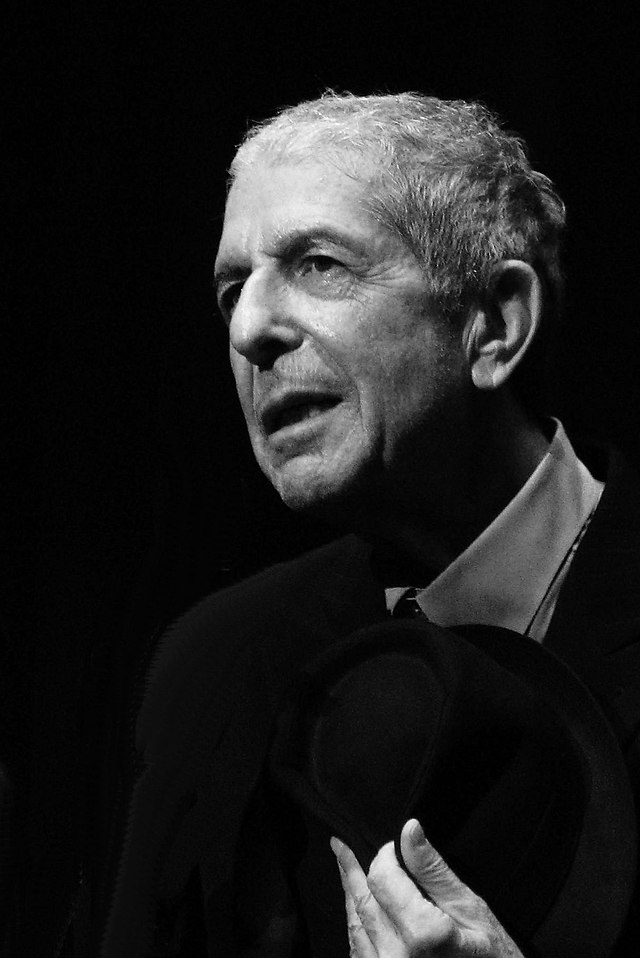Friday Extras: 3 songwriter-poets
"Leonard Cohen 2187-edited" by Rama - Own work. Licensed under CC BY-SA 2.0 fr via Wikimedia Commons - http://commons.wikimedia.org/wiki/File:Leonard_Cohen_2187-edited.jpg#/media/File:Leonard_Cohen_2187-edited.jpg
1. Paul Simon.
Now, just to be clear, not every Paul Simon song works without its music. In the book of his collected lyrics, words like "la la la" made it onto the pages. "La la la" doesn't usually work in a poem. But several of his stanzas and some of his full songs are definitely more poem than song. From his Simon and Garfunkel days, "The Dangling Conversation,""The Boxer" (minus the "lie - lie- lies"), and my favorite, "America," could all stand alone on the page:
“Kathy, I’m lost,” I said, thought I knew she was sleeping.
“I’m empty and aching and I don’t know why”
Counting the cars on the New Jersey Turnpike
They’ve all come to look for America
The music of these songs only heightens their haunting effect. Also, "Punky's Dilemma" and, to a lesser extent, "A Simple Desultory Philippic" could have come out of the pages of an O'Hara Collection. In Simon's solo career, his music writing shifts to accommodate his poetic leanings, so that the line between poem and song is more porous. My favorite is probably "Hearts and Bones":
One and one-half wandering Jews
Free to wander wherever they choose
Are traveling together
In the Sangre de Cristo
The Blood of Christ Mountains
Of New Mexico
On the last leg of the journey
They started a long time ago
The arc of a love affair
Rainbows in the high desert air
Mountain passes slipping into stones
Hearts and bones
2. Leonard Cohen
Seeing as Cohen was a poet before he was a songwriter, this one should be a gimme. But songs are different from poems; they often depend on their music for their effect, and Cohen has said that for him, the words and music grow up together and influence one another throughout the writing process. Nevertheless, his lyrics have great effect on the bare page. Take his breakout hit, "Suzanne" for example:
Now Suzanne takes your hand
And she leads you to the river
She is wearing rags and feathers
From Salvation Army counters
And the sun pours down like honey
On our lady of the harbour
And she shows you where to look
Among the garbage and the flowers
There are heroes in the seaweed
There are children in the morning
They are leaning out for love
And they will lean that way forever
While Suzanne holds the mirror
Cohen's most-covered song, "Hallelujah" also stands even without the beauty of its aching melody, stretching out across those "Hallelujahs," even though the melody adds a lot to its effectiveness. Most often, though, I find that Cohen's music gets in the way of the words. He's not a great singer and many of his production choices are awkward, but his lyrics keep me coming back every time, like the tragic beauty of these classic lines:
Dance me to your beauty with a burning violin
Dance me through the panic 'til I'm gathered safely in
Lift me like an olive branch and be my homeward dove
Dance me to the end of love
3. Bob Dylan
What kind of a Bob Dylan scholar would I be if I didn't mention him? The truth is, though, that it's hard for me to separate Dylan's lyrics from his melodies. Dylan is primarily a songwriter and most of his songs work best as songs. Every now and then, though, Dylan gives us a poem. For example, aside from the chorus, which works best with the rising melody, "A Hard Rain's Gonna' Fall" is a wonderful, incantatory poem, channeling Ginsberg and Whitman:
Oh, what did you see, my blue-eyed son?
Oh, what did you see, my darling young one?
I saw a newborn baby with wild wolves all around it
I saw a highway of diamonds with nobody on it
I saw a black branch with blood that kept drippin’
I saw a room full of men with their hammers a-bleedin’
I saw a white ladder all covered with water
I saw ten thousand talkers whose tongues were all broken
I saw guns and sharp swords in the hands of young children
And it’s a hard, and it’s a hard, it’s a hard, it’s a hard
And it’s a hard rain’s a-gonna fall
Read more: http://www.bobdylan.com/us/songs/hard-rains-gonna-fall#ixzz3Y9HpGdQx
The famous description of these and other Dylan lyrics as "chains of flashing images" is similar to the poetic goals of the New York School, but because these are song lyrics, they have an ear-catching rhythmic quality that makes them more effective than those dada-ist exercises. Again, except for the chorus, "Like a Rolling Stone" is a great example of this abstract expressionist trend in Dylan's work:
Princess on the steeple and all the pretty people
They’re drinkin’, thinkin’ that they got it made
Exchanging all kinds of precious gifts and things
But you’d better lift your diamond ring, you’d better pawn it babe
You used to be so amused
At Napoleon in rags and the language that he used
Go to him now, he calls you, you can’t refuse
When you got nothing, you got nothing to lose
You’re invisible now, you got no secrets to conceal
How does it feel
Read more: http://www.bobdylan.com/us/songs/hard-rains-gonna-fall#ixzz3Y9Jf6xYK
Well, that's all for me for national poetry month. If you're interested in Bob Dylan, you might like to hear about that time I saw Dylan live and it reminded me of that video where a cat plays piano. If you're into Paul Simon you might appreciate this mini-ode to Simon and Garfunkel.




Comments
Post a Comment
Thanks for leaving your kind and thoughtful comments.